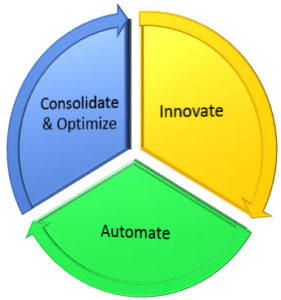 Technological innovation is often described as happening in “leaps and bounds.” As cliche as it sounds, it remains accurate through a significant cross section of technological advancements. Beyond the simplicity of this cliche exists an opportunity for businesses to get ahead in their objectives using automation.
Technological innovation is often described as happening in “leaps and bounds.” As cliche as it sounds, it remains accurate through a significant cross section of technological advancements. Beyond the simplicity of this cliche exists an opportunity for businesses to get ahead in their objectives using automation.
Innovations are temporary solutions
Innovations in computing are making their way into the mainstream at an impressive rate. The most important and significant of these innovations often started their lives as solutions to problems created by previous innovations. By virtue of this, it is assumed then that all innovations run the very likely risk of being temporary until a new innovation comes about to supplant it.
Few innovations are brilliant ideas that materialized from nothing. Most are incremental exercises in problem solving, discovery and good old trial and error. One of the most powerful tools available to work with to accomplish this in computing is automation. Most added value tools (API’s, Queryable Databases, Feature Extensions, etc.) are costly to leverage and rarely return value at a small scale. In contrast, automation is typically available across a broad spectrum of solutions and in flavors that are more accessible and yield results at a more affordable rate.
Amplifying the value of an innovation through automation
Automation is often the first and easiest way that operations can begin exploiting an innovation to discover new value by removing additional human or machine effort, cost and complexity. This is true for businesses of all shapes and sizes. The challenge that is presented is one of what to automate, at what cost and what benefit to the business.
Some years ago, before the introduction of Group Policy by Microsoft, I created a series of scripts over the course of 30 hours that would manage critical Windows Settings, deploy software and perform routine maintenance on desktop computers. I calculated that this automation saved my company 400-500 hours of IT labor over the next 2 years. Instead of a technician running around to each station to handle these tasks, the scripting system handled it for me. Later, I added logging and reporting so I could perform analysis to see where the scripts weren’t working and make adjustments.
Normalizing the benefits of automation
Once an innovation has been successfully automated, it demonstrates the innovation’s value at scale. This leads to the inevitable consolidation and optimization of the combined original innovation, automation and new thinking that comes with it.
In my scripted Windows desktop management example, eventually Microsoft finally got Group Policy right. Once the new Group Policy technology was mature enough, I transitioned my scripts over to GPO. Over time, I would add new policies to GPO that would enhance user productivity and continue to save on the potential IT labor that the feature introduced. It also made it easier for other administrators to come in and help out with policy changes and management.
Innovating in your business before tech does it for you
It’s important to understand that many innovations that found their way into the mainstream started out as an automation project in the operations of the organizations determined to make the most of their investments and gain competitive advantage. I’m not trying to suggest that automation is the only way to drive innovation – it’s not – it is, however, something that is accessible to your business and has a fantastic track record of success.
Organizations that leveraged some form of automation in their operations to create value before it was consolidated into commercially available products held an untouchable competitive advantage for a time. It takes an entrepreneurial mindset and technical acuity to successfully innovate within your operations. Before you dismiss the possibilities of what your operations could be doing, it’s worth it to dream a little and challenge your technology specialists to participate and deliver.
I get to do this every day in my consulting practice for my customers. We have created many automated solutions before they were commercially available – from real-time BIM Collaboration Platforms to on-demand Image Scaling solutions within web applications. Automation is a powerful tool in today’s app-economy that seems to have a solution for everyone. Why? Simply put – when everyone has the same solution, the playing field is leveled. Your ability to add value over your competition is marginalized. By using automation to bring new value to your business proposition, you position your firm to deliver better design, higher quality services and an unmatched experience for your customer.
Leave a Reply